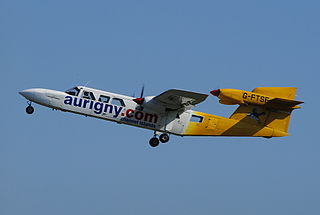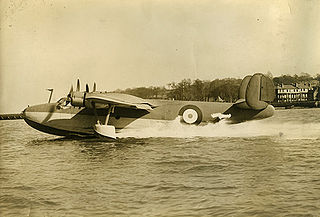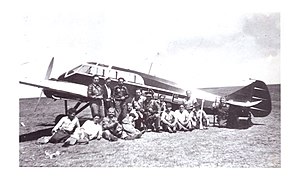
The Bristol Type 170 Freighter is a British twin-engine aircraft designed and built by the Bristol Aeroplane Company as both a freighter and airliner. Its best known use was as an air ferry to carry cars and their passengers over relatively short distances. A passenger-only version was also produced, known as the Wayfarer.

The Britten-Norman Trislander is a three-engined piston-powered utility aircraft designed and produced by the British aircraft manufacturer Britten-Norman.

The de Havilland Express, also known as the de Havilland D.H.86, was a four-engined passenger aircraft manufactured by the de Havilland Aircraft Company between 1934 and 1937.

The Boulton Paul P.29 Sidestrand was a twin-engine biplane medium bomber of the Royal Air Force. Designed for daylight operations, it was manoeuvrable and provided with three defensive gun positions. Named after a village on the Norfolk coast near Boulton & Paul's factory in Norwich, the Sidestrand first flew in 1926 and entered service in 1928. It remained in service until 1936, equipping No. 101 Squadron RAF. It was an agile and relatively fast aircraft that was capable of aerobatic manoeuvres such as loops, rolls and spins.

The Fairey Aviation Company Fairey III was a family of British reconnaissance biplanes that enjoyed a very long production and service history in both landplane and seaplane variants. First flying on 14 September 1917, examples were still in use during the Second World War.

The Vickers Virginia was a biplane heavy bomber of the British Royal Air Force, developed from the Vickers Vimy.

The Hawker Hornbill was the last Hawker military aircraft designed under the direction of George Carter. The design was started in 1925 and the first flight took place in July 1925. The Hornbill did not achieve service in the Royal Air Force due to problems in its power plant and radiator. Only one aircraft was built.

The Airspeed Consul is a twin-engined light transport aircraft and affordable airliner designed and produced by the British aircraft manufacturer Airspeed Limited. Introduced during the immediate post-war period, it was a straightforward conversion of surplus Airspeed Oxford military trainers that had been extensively used during the Second World War.
General Aircraft Limited was a British aircraft manufacturer from its formation in 1931 to amalgamation with Blackburn Aircraft in 1949 to become Blackburn and General. Its main products were military gliders and light transport aircraft.

The Avro 549 Aldershot was a British single-engined heavy bomber aircraft built by Avro.

The Boulton & Paul P.64 Mailplane also known as the Mail-Carrier was a 1930s British twin-engined all-metal biplane transport aircraft designed for Imperial Airways and built by Boulton & Paul Ltd.

The Airspeed AS.39 Fleet Shadower was a British long-range patrol aircraft design that did not go beyond the prototype stage. A similar aircraft, the General Aircraft Fleet Shadower, was also built to the extent of prototypes. While the concept of a fleet shadower had some promise, the resulting designs were soon overtaken by wartime developments in airborne radar.

The de Havilland DH.50 was a 1920s British large single-engined biplane transport built by de Havilland at Stag Lane Aerodrome, Edgware, and licence-built in Australia, Belgium, and Czechoslovakia.

The Saunders Roe A.37 Shrimp was a 1930s British two-seat four-engined experimental flying boat built by Saunders-Roe Limited ("Saro") at Cowes.

The Armstrong Whitworth AW.15 Atalanta was a four-engine airliner designed and produced by the British aircraft manufacturer Sir W.G. Armstrong Whitworth Aircraft Limited at Coventry.
The Folland Fo.108, also known as the Folland 43/37 and by the nickname Folland Frightful, was a large monoplane engine testbed aircraft of the 1940s.

The Dornier Komet (Comet), Merkur (Mercury), Do C, Do D, and Do T were a family of aircraft designed and manufactured by the German aircraft manufacturer Dornier Flugzeugwerke.

The General Aircraft Monospar was a family of touring and utility aircraft designed and built by the British aviation company General Aircraft Ltd (GAL).
The General Aircraft GAL.55 was a 1940s British military training glider designed and built by General Aircraft Limited.

The Rohrbach Ro IV, also known as the Beardmore BeRo.2 Inverness was an all-metal monoplane flying boat of the 1920s. Designed by the German company Rohrbach for the British Royal Air Force, two were ordered, one completed by Rohrbach's Danish subsidiary and the second by the British licensees, William Beardmore and Company, but the type performed poorly during testing and was abandoned.



















